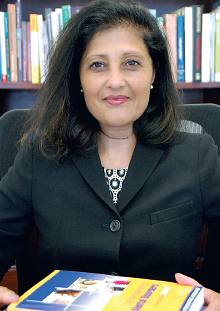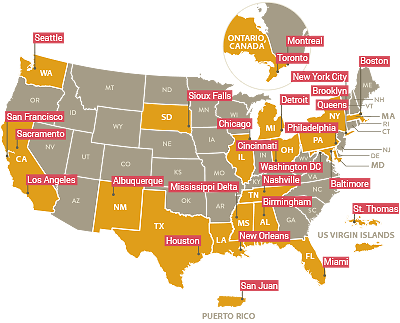DDHE Director Speaks About the Importance of Diversity in Psychiatry
Abstract
The mission of APA’s Division of Diversity and Health Equity is to meet the professional needs of psychiatrists from minority and underrepresented groups and improve the quality of care for minority and underserved populations.
July is APA’s Diversity Mental Health Month, a month during which the mental health needs of diverse populations are spotlighted, as well as the importance of continued training in cultural competence by the health care professionals who serve them. Last year APA launched Diversity Mental Health Month, which is spearheaded by the Division of Diversity Health Equity (DDHE), formally known as the Office of Minority and National Affairs. Since July 2014, the division has undergone some change, including the appointment of Ranna Parekh, M.D., M.P.H., as DDHE director. In an interview with Psychiatric News, Parekh discusses the purpose of APA Diversity Mental Health Month and the future of DDHE.

Ranna Parekh, M.D., M.P.H., believes that as patient demographics continue to change and as more diverse groups access mental health care, the way in which health care professionals approach diversity has to broaden.
PN: What is APA Diversity Mental Health Month?
RP: Diversity Mental Health Month was created two years after Steve Koh, M.D., M.P.H., M.B.A., Barton Blinder, M.D., Ph.D., and Joseph Mawhinney, M.D., wrote an action paper calling for APA to designate a month to spotlight diversity initiatives—looking at patient health care disparities, workforce diversity, and cultural competency issues. They thought it was important to designate a month that really focused on the importance of the diversity of our members, the patients we serve, and the science that informs our work as psychiatrists.
PN: Why do psychiatrists need to be sensitive to diversity issues?
RP: It is important that people recognize that disparities exist in access to mental health care. The U.S. Department of Health and Human Services reports that Hispanics and African Americans are, respectively, 30 percent and 40 percent less likely to receive any mental health care services than whites. Asians are 50 percent less likely to access mental health care than whites. One of the hopes for Diversity Mental Health Month is to provide a platform that makes health care disparities more visible.
Whenever a psychiatrist interfaces with a patient with a background different from his or her own, there is going to be a huge range of differences in how they view the world around them. Psychiatrists need to be aware of how their cultural, racial, and ethnic background differs from those of their patients so they are able to provide their patients with the best care possible.
PN: How do you define “diversity?”
RP Diversity is a broad term that continues to evolve. Our division was created in 1974 as the Office of Minority and National Affairs. Its purview expanded through the years until it became clear that we needed a new name for the department that reflected the broader mission we have today.
APA has long been committed to racial and ethnic groups who have a long history of health disparities and have been underrepresented in the field of psychiatry, including Asians, American Indian, Hispanics, and African Americans. At the same time, we want to evolve with the definition of diversity to include other groups, such as women; members of the lesbian, gay, bisexual, and transgender (LGBT) community; religious minorities; internationals; and those who are underrepresented geographically.
PN: You’ve been DDHE director since January. How do you like your position?
RP: I feel really fortunate. I get to think about ways to improve diversity in psychiatry every day—this is a dream job come true. Prior to coming here, I worked as a practicing psychiatrist at Massachusetts General Hospital for 15 years. I loved being a practicing physician, but having the opportunity to work with 36,000 members, seven minority/underrepresented caucus groups, an incredible council on minority mental health and health disparities, and a great DDHE team has been absolutely amazing.

Locations of meetings, community outreach, and “On Tour” programs where DDHE has gathered physicians, patients, and advocates of mental health care to address mental health disparities of minority populations.
It has also been exciting to be a part of the APA administration and work with our elected leaders who have made diversity issues a top priority for the organization.
[Note: The seven minority/underrepresented caucuses represent American Indian, Alaska Native and Native Hawaiian psychiatrists; Asian-American psychiatrists; black psychiatrists; Hispanic psychiatrists; international medical graduates; lesbian, gay and bisexual psychiatrists; and women psychiatrists.]
PN: What is your vision for DDHE?
RP: Part of my goal is to continue to develop the great work that APA is already doing. This work includes continuing to grow the minority fellowship programs, which at their core is about increasing workforce diversity—a platform of one of my predecessors, Jeanne Spurlock, M.D. We are also looking to expand in the areas of education, research, as well as partnerships with APA district branches, governmental agencies, and community and other mental health advocacy organizations.
At this year’s annual meeting, we had the first “conversation” in a series on diversity and health equity. Through this candid dialogue with members, DDHE now has a better idea about what programs need to be continued, improved upon, or discontinued and what new programs members would like to see added. The “conversations” event was the first step in APA reimagining what the DDHE can mean for our members and the patients we serve. We plan to make these conversations with members a regular part of future annual meetings and the IPS: The Mental Health Services Conference.
PN: What events does DDHE have planned for later this year?
RP: We will have a “DDHE on Tour” program at this year’s IPS: The Mental Health Services Conference in New York City in October on domestic violence (see page 10). This will be a very unifying event where the seven minority caucuses will be able to participate because domestic violence affects all ethnic racial, geographical, cultural, and socioeconomic groups. Psychiatrists should be leaders in mental health issues surrounding domestic violence, especially as it relates to destigmatizing help for victims. We should also be trained to provide better services to this population.
PN: What do you want APA members to know about DDHE?
RP: My hope is that APA members know that DDHE represents them. Also, they should be aware that we offer a valuable resource to which they can turn when faced with questions about how best to work with patients of different backgrounds. Our plan is to build a robust website with more resources for our members that will ultimately help them provide better care for all patients seeking mental health services. ■
The DDHE toolkit for APA Diversity Mental Health Month can be accessed here.



